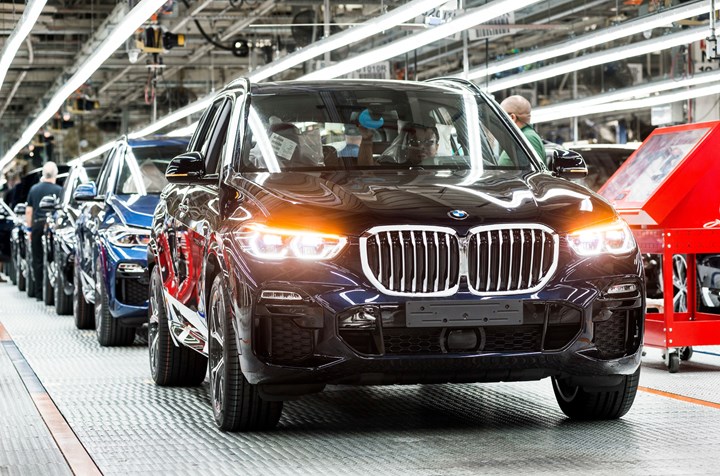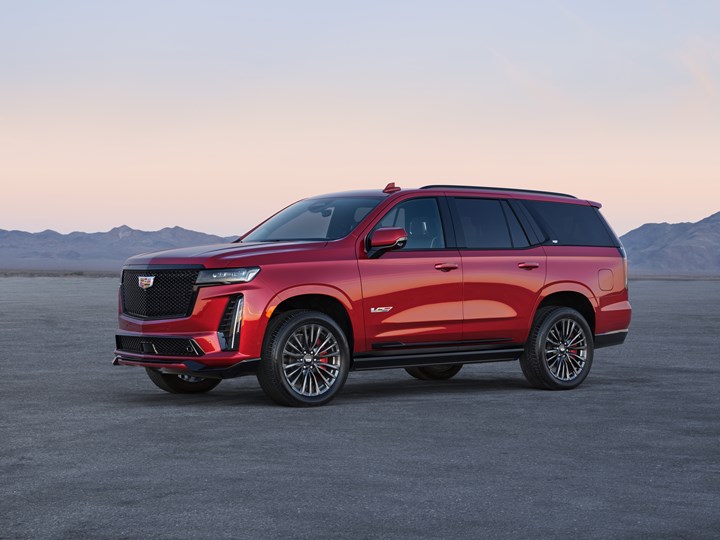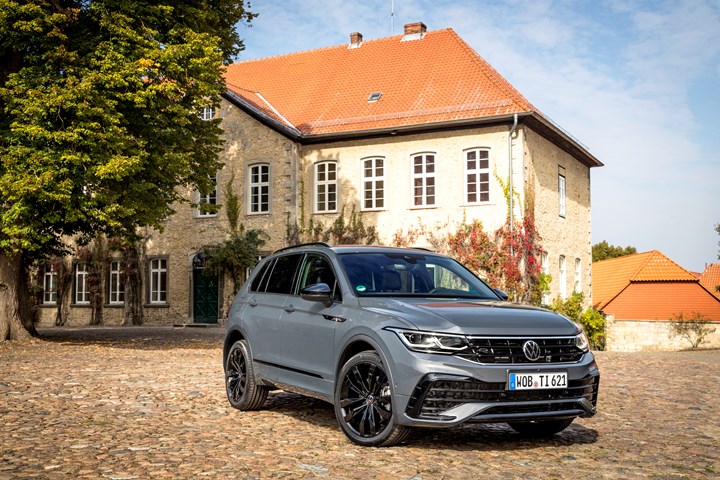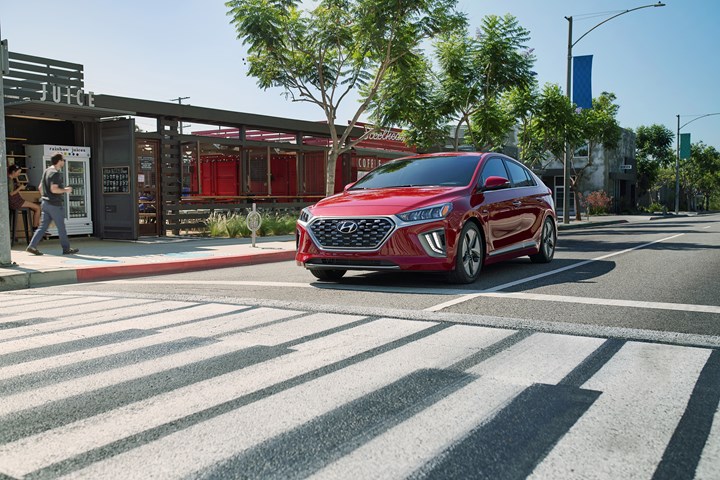on BMW Building SUVs, Diesels (still) & the Bronco Raptor
BMW is building a serious number of SUVs in South Carolina. . .Cadillac’s EV future and Escalade’s present. . .VW still makes diesel vehicles. . .impressive MPG numbers for hybrids. . .Renault’s transformation and some possibly prescient observations from Bob Lutz. . .the Hyundai Santa Cruz. . . Bronco Raptor specs are remarkable
Building BMWs in South Carolina, 2021

BMW builds SUVs in Spartanburg, South Carolina. Lots of SUVs. (Image: BMW)
Chip shortage?
Well, maybe it limited what the folks at BMW Plant Spartanburg could have done in 2021, but be that as it may, they pretty much smashed the existing production record with the manufacture of 433,810 units.
This is the fourth time the factory in South Carolina has topped 400,000 units.
- 2015: 400,904
- 2016: 411,171
- 2019: 411,620
Plant Spartanburg is the company’s global lead crossover plant.
In 2021, including standard and M variants, the production consisted of:
- X3: 118,249
- X4: 55,490
- X5: 170,681
- X6: 38,605
- X7: 50,724
Of those vehicles, some 40,000 of the X5 models were hybrids and more than 30,000 of the X3s were.
Dr. Robert Engelhorn, president and CEO of BMW Manufacturing:
“Electric mobility is becoming a growth driver and success factor for the company. Our plant is fully on board to support BMW Group’s electrification strategy. We look forward to adding the all-new BMW XM to the Plant Spartanburg family of X models. Series production of the BMW XM, the first plug-in hybrid high-performance model in the BMW M portfolio, will begin in late 2022.”
In 2021 BMW led the sales of the luxury brands (BMW: 336,694, Mercedes: 329,665, Lexus: 326,928).
Plant Spartanburg played no small role in that result as 179,840 of the vehicles sold by BMW in the U.S. were produced in South Carolina.
///
Still Gas in the Tank

2023 Cadillac Escalade V. The Escalade is an immensely important vehicle for Cadillac. In 2021 there were 40,505 of the SUVs delivered, a 65% increase over 2020 sales. (Image: Cadillac)
On January 20 GM president Mark Reuss posted a piece on LinkedIn about the first pre-production Cadillac LYRIQ being produced at the assembly complex in Spring Hill, Tennessee.
Reuss wrote, in part:
“15 months ago we announced a $2 billion investment into Spring Hill to build fully electric vehicles. Our teams have worked tirelessly on the LYRIQ, bringing the launch up nine months ahead of schedule and working in parallel to convert the plant and start production. This is an important proof point in our path to EV leadership as we introduce more high-volume EVs across price points and lifestyles.”
The next day Cadillac announced:
“The 2023 Cadillac Escalade will be the first SUV to don the high-performance V-Series badge. With nearly two decades of racing-inspired prowess, the V-Series designation is reserved for vehicles that encompass the peak of Cadillac performance, bold, distinguished design, and innovative technology.”
While additional details are coming later, the likelihood this will be an electric Escalade is about zero.
Although Cadillac is supposed to be an “all-electric” brand by the end of the decade, between now and then the brand needs to make some money.
Thus, the Escalade V-Series.
Note: This is not to minimize GM’s commitment to EVs because on January 25 Mary Barra announced an investment of some $7-billion in four Michigan manufacturing sites, most of which is being spent on EV-related capacity. When the GM Orion Assembly Plant—where the Chevy Bolt and Bolt EV are, and will continue to be, built—is transformed as a result of a $4-billion investment, GM will have the capacity (including Factory ZERO in Detroit/Hamtramck) to produce 600,000 light trucks (e.g., HUMMER EV and Silverado EV) in Michigan. GM and LG Energy Solution are investing $2.6-billion in a new battery plant, Ultium Cells Lansing. Barra said that with this investment Michigan is becoming the global “epicenter of EVs.” Here’s something to consider: Barra also announced a >$510-million investment for the Lansing Grand River Assembly and Lansing Delta Township Assembly plants, where ICE vehicles are based. That $510-million is remarkable yet is pales in comparison to the other announced investments.
///
Diesel in Europe (and Paraffinic Fuel)

This Tiguan diesel, like other VW diesel models delivered since the end of June 2021, can run on paraffinic diesel fuels, which are made from biological residual and waste materials, including cooking oil and sawdust. (Image: VW)
“Volkswagen plans to reduce the carbon footprint of its fleet in Europe by 40 percent by the year 2030. The company is therefore increasingly focusing on fully and partially electric vehicles. As a further alternative, Volkswagen is now officially approving models with the latest-generation 4-cylinder diesel engines for use with paraffinic fuels. These newly developed diesel fuels containing bio-components permit significant CO2 savings of 70-95 percent compared with conventional diesel.”
That is a statement from Volkswagen AG. From last month.
Yes, diesel.
Of course, there is that reference to the bio-based fuel.
According to LMC Automotive, it is likely that light-duty diesel sales in western Europe will finish 2021 at 21.% of the market. (They are still crunching some final numbers, but are confident they’re close.)
In 2020 the share was 27.9%.
In Germany, where Rudolf Diesel lived for the better part of his life, diesels account for 25.5% of the 2021 market, down 4.5% from 2020.
In France, where Mr. Diesel was born, there was a steeper decline, from 31.9% in 2020 to 23.2% in 2021.
That said, those numbers translate into 668,600 diesels in Germany and 384,400 in France, so it is not like it is a trivial number.
Volkswagen Group (as in the whole thing, from Audi to VW brand) delivered 310,400 battery electric vehicles in Europe in 2021.
///
Where’s Detroit?

The Hyundai IONIQ hybrid. Think about this: an 11.9-gallon gas tank and an estimated combined 59 mpg. 702 miles per tank. (Image: Hyundai)
Here is a list of the top- 2022 vehicles without a plug with the best fuel economy according to the EPA (combined mpg rating in the parentheses):
- Hyundai Ioniq Blue, 1.6-liter, four cylinder, automatic transmission (59)
- Toyota Prius Eco, 1.8-liter, four-cylinder, CVT (56)
- Hyundai Ioniq, 1.6-liter four, automatic (55)
- Hyundai Elantra Hybrid Blue, 1.6-liter four, automatic (54)
- Honda Insight, 1.5-liter four, CVT (52)
- Hyundai Sonata Hybrid Blue, 2.0-liter four, automatic (52)
- Toyota Camry Hybrid LE, 2.5-liter four, automatic (52)
- Toyota Corolla Hybrid, 1.8-liter four, CVT (52)
- Toyota Prius, 1.8-liter, CVT (52)
- Hyundai Elantra Hybrid, 1.6-liter four, automatic (50)
- Kia Niro FE, 1.6-liter four, automatic (50)
- Kia Niro, 1.6-liter four, automatic (49)
- Toyota Prius AWD, 1.8-liter four, CVT (49)
- Honda Insight Touring, 1.5-liter four, CVT (48)
- Honda Accord Hybrid, 2.0-liter four, CVT (47)
- Hyundai Sonata Hybrid, 2.0-liter four, automatic (47)
- Toyota Camry Hybrid SE/XLE/XSE, 2.5-liter four, automatic (46)
That was supposed to be a top-10 list, but as you can see there are lots of ties.
What you don’t see are lots of names like Chevy, Ford or Chrysler.
While there is something to be said for EV developments being undertaking by the group formerly known as the “Big Three,” it is not like Honda, Hyundai, Kia and Toyota aren’t in the space, as well.
///
Will Tech Guys Be the 21st Century Finance Guys?

Renault is undergoing a transformation to prepare it for the future, which seems to be more than about moving sheet metal. (Image: Renault)
Although I’ve never had the opportunity to meet the man, the announcement that Guido Haak was named the executive vp of the Renault Group Advanced Product Planning Group caught my eye because the man obtained a Ph.D. in theoretical physics from the Free University of Berlin.
What’s more, he spent four years performing research in and teaching mathematics in the U.S. and Germany.
Theoretical physics? Math research?
But in 1998 he joined McKinsey as a consultant in tech and automotive. In 2005 Haak joined Volkswagen Group and had top positions at Audi, VW brand and Skoda.
Luca de Meo, Renault Group CEO:
“By defining our future vehicles and ranges, Guido Haak will be directly at the source and of the development of the Renault Group performance. With his successful experience in major groups, I am sure that he will be a strong asset for the reconquest of the C segment and more widely for the success of the vehicles of our Renaulution plan.”
Renaulution
When announcing the Renaulution plan in January 2021—which is about efficiency, profitability, mobility, and the like—de Meo said, in part:
“We’ll move from a car company working with tech to a tech company working with cars, making at least 20% of its revenues from services, data and energy trading by 2030.”
All of which got me to thinking:
Back in 2011 Bob Lutz, car guy extraordinaire, released a book titled Car Guys vs. Bean Counters. In it, Lutz writes of a change that occurred at General Motors in the late ‘70s:
“From now on, products would be initiated by Product Planning (a department composed of recycled finance types); they would ferret out market segments and define exterior dimensions and interior roominess to the millimeter. Engineering suddenly had a lot more say in what went where, and Manufacturing weighed in massively on questions of ease of assembly and number of stamping dies per panel. . . .
“As a result, the system created research-driven, focus-group-guided, customer-optimized transportation devices, hamstrung in countless ways, using a chassis too narrow here, wheels too small (but affordable!) there, and all sharing too much with the other brands. At the end of the ‘creative’ process, the designers were now reduced to the equivalent of choosing the font for the list of ingredients on a tube of Crest.”
Maximum Bob
Lutz, who was at GM as an exec when this approach, in part, led to the company filing for bankruptcy, a man who is a champion of the imagination brought to vehicles by designers, argued in the book:
“The shift to the predictable, so seductive to the bean counters, destroyed the company’s ability to compete and conquer.”
And:
“I maintain that without a passionate focus on great products from the top of the company on down, the ‘low cost’ part will be assured but the ‘high revenue’ part won’t happen, just as it didn’t at GM for so many years.”
The book is from a decade ago. And Lutz was writing about what happened for decades before that date.
But here’s the point of this:
Is it possible that as the auto industry focuses its efforts on technology—electrification, automation—in order to transform itself into a purveyor of mobility services and other things, the passionate pursuit of products people want will be abandoned by the side of the road?
///
2022 Hyundai Santa Cruz Limited AWD

The Hyundai Santa Cruz: Style meets function. (Image: Hyundai)
There are people who need—for vocational or avocational reasons—a pickup truck. People ranging from contractors to recreational carpenters.
There are people who want a pickup truck—just because. Just in case.
There are people who want a pickup truck because they like the looks or because it tells the world that they are driving, well, a pickup truck.
Did you ever notice how gas stations tend to be located adjacent to one another? That’s because the companies realize it is a spot with great opportunity.
Two in One (Year)
So the fact that two compact pickup trucks emerged in 2021—the Hyundai Santa Cruz and the Ford Maverick—shouldn’t be entirely surprising, especially as this a vehicle type that has been long absent from the scene and a segment with huge potential.
The facts that (a) they both have truck beds, (b) they are approximately the same size and (c) they both launched in 2021 have led people to make one-on-one comparisons between the Ford Maverick and the Hyundai Santa Cruz.
While I acknowledge (a), (b) and (c), these comparisons, I think, really miss the point.
Ice Cream Analogy
Let’s say you go to a Dairy Twirl or whatever a local independent ice cream stand in your locale may be. You are interested in a sweet beverage, so you order one.
It is served in a cup. You drink it with a straw. It is cold. It is sweet.
But it may be a shake or it may be a slush.
Both beverages that have similarities in form factors (cup, straw, liquidity) and function (slaking thirst).
But no one is going to confuse a chocolate shake and a strawberry slush.
Which is why I think the comparison between the Maverick and the Santa Cruz is not particularly germane.
There are some people who want a truck that looks like a truck and acts like a truck.
So there’s the Maverick.
There are those who want a comfortable, well-appointed, capable vehicle that has a bed on the back.
So there’s the Santa Cruz.
Hyundai models of late have exterior designs that are contemporary without being kooky.
The Santa Cruz styling is well executed which might lead some people to question its capability.
[Small] Truck Numbers
Know that the base model has a 1,753-pound payload capacity and 3,500 pounds for trailering (with trailer brakes). It has a 4.3-foot box that is based on composite materials. There is an available tonneau cover (standard on the two top trims and optional on another, leaving the base model without the opportunity); metal, not fabric and lockable.
The vehicle driven has a turbocharged 2.5-liter engine that produces 281 hp and 311 lb-ft of torque. (With this engine, towing goes up to 5,000 pounds.) It is mated to an eight-speed wet dual-clutch transmission. (Yes, you can paddle shift.)
The interior of the Limited trim includes leather, an 8-way adjustable driver seat, a 10.25-inch color touchscreen, and an attention to both materials and fit and finish such that I wonder if you were hauling dirt whether you’d not want to get inside the cab because it is so nice.
And there is a lengthy list of active safety systems, including: Forward Collision-Avoidance Assist (FCA) with Pedestrian Detection, Blind-Spot Collision Avoidance Assist, Rear Cross-Traffic Collision Avoidance Assist, Surround View Monitor, Blind View Monitor, Leading Vehicle Departure Alert (this one always surprises me: when stopped at a light behind another vehicle, when that vehicle begins to pull away there is a notification that that’s happening because sometimes—admit it—we’re not always paying attention), Intelligent Speed Limit Assist. . .and on it goes.
Purposeful
For suburbanites and urbanites alike who make the occasional trip to Home Depot or the regular trip to Costco (that locking tonneau cover cannot be underestimated), the Santa Cruz does the trick because odds are they don’t need the truck characteristics most of the time (seriously: how often do you tow something in a given year or have to transport a load that makes springs tired?) but they’re available when they’re needed.
///
Something More About the Bronco Raptor

Once you remove the sheet metal, glass, seats. . .you get to the bones of the Bronco Raptor. (Image: Ford)
By now you’ve probably seen multitudinous pictures of the 2022 Ford Bronco Raptor. The street-legal rock-crawler/desert racer. What Carl Widmann, Ford Performance chief engineer, describes as “our ultimate vehicle for hardcore off-road enthusiasts who demand something more.”
So as you can see above, that’s what’s under the skin of the Bronco Raptor. The fully boxed high-strength steel frame. The High-Performance Off-Road Stability Suspension System (HOSS) Ford engineers developed with those from FOX. The 37-inch BFGoodrich KO2 all-terrain tires.
Here are some things about the Bronco Raptor that fall within Widmann’s “something more,” as in more than the standard Bronco:
- +8.6 inches: rear track increase. To 73.6 inches.
- +9.8 inches: vehicle width (mirrors folded) increase. To 85.7 inches.
- +4.8 inches: ground clearance increase. To 13.1 inches.
- +60%: front wheel travel. To 13 inches.
- +40%: rear wheel travel. To 14 inches.
- +1,000 pounds: towing capacity increase. To 4,500 pounds.
Funny thing: The numbers of the “regular” Bronco are impressive. Now they’ve dialed it to 11.
RELATED CONTENT
-
On Electric Pickups, Flying Taxis, and Auto Industry Transformation
Ford goes for vertical integration, DENSO and Honeywell take to the skies, how suppliers feel about their customers, how vehicle customers feel about shopping, and insights from a software exec
-
On The Jeep Grand Cherokee, 2022 Nissan Pathfinder, and More
An inside look at the Detroit Assembly Complex-Mack; a innovative approach to waste-free, two-tone painting; why a forging press is like an F1 car; and other automotive developments.
-
GAC, CATL Partner on Two Battery Ventures
Two new battery ventures are being formed in China by domestic carmaker Guangzhou Automobile Group Ltd. and battery giant Contemporary Amperex Technology Ltd.


.jpg;width=70;height=70;mode=crop)






